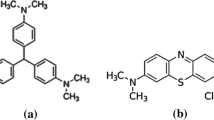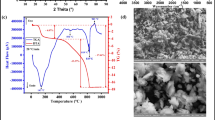Abstract
The sorption of Acid Blue 9 onto the mixture of activated clay and activated carbon has been studied in terms of pseudo-first order and pseudo-second order chemical sorption processes. The batch sorption model, based on the assumption of a pseudo-second order mechanism, has been developed to predict the rate constant of sorption and the equilibrium capacity with the effect of initial dye concentration, mass of mixed sorbent, temperature and initial solution pH. The rates of sorption were found to conform to pseudo-second order kinetics with good correlation. Batch isotherm studies showed that the sorption of Acid Blue 9 by the mixed sorbent from aqueous solution was described by the Langmuir isotherm equation. A comparison of the evaluated equilibrium capacity of sorption has been made by the pseudo-second order rate equation as well as by the Langmuir isotherm and operating line method. In addition, an activation energy of sorption has also been determined based on the pseudo-second order rate constants.
Similar content being viewed by others
References
Ahmed, M.N. and R.N. Ram, “Removal of Basic Dye from Wast-Water Using Silica as Adsorbent,” Environ. Pollut., 77, 79–86 (1992).
Asfour, H.M., O.A. Fadali, M.M. Nassar, and M.S. El-Geundi, “Equilibrium Studies on Adsorption of Basic Dyes on Hardwood,” J. Chem. Technol. Biotechnol., 35, 21–27 (1985).
Gupta, G.S. and S.P. Shukla, “An Inexpensive Adsorption Technique for the Treatment of Carpet Effluents by Low Cost Materials,” Adsorpt. Sci. Technol., 13, 15–26 (1996).
Gupta, G.S., G. Prasad, and V.N. Singh, “Removal of Chrome Dye from Aqueous Solutions by Mixed Adsorbents: Fly Ash and Coal,” Water Res., 24, 45–50 (1990).
Gupta, G.S., S.P. Shukla, G. Prasad, and V.N. Singh, “China Clay as an Adsorbent for Dye House Wastewaters,” Environ. Technol., 13, 925–936 (1992).
Gupta, V.K., D. Mohan, and S. Sharma, “Removal of Lead from Wastewater Using Bagasse Fly Ash-ASugar IndustryWaste Material,” Sep. Sci. Technol. 33, 1331–1343 (1998).
Ho,Y.S., “Adsorption of Heavy Metals fromWaste Streams by Peat,” Ph.D. Thesis, The University of Birmingham, Birmingham, U.K., 1995.
Ho,Y.S. and G. McKay, “A Kinetic Study of Dye Sorption by Biosorbent Waste Product Pith,” Resour. Conserv. Recycl., 25, 171–193 (1999).
Ho, Y.S. and G. McKay, “Kinetic Models for the Sorption of Dye from Aqueous Solution by Wood,” Process Saf. Environ. Protect., 76 (B), 183–191 (1998).
Ibrahim, N.A., A. Hashem, and M.H. Abou Shosha, “Amination of Wood Sawdust for Removing Anionic Dyes from Aqueous Solutions,” Polym.-Plast. Technol. Eng., 36, 963–971 (1997).
Khalil, L.B. and B.S. Girgis, “Column Removal of Some Dyestuffs by Activated Carbons Derived from Apricot Stone Shells,” Adsorpt. Sci. Technol., 16, 405–414 (1998).
Khattri, S. and M.K. Singh, “Colour Removal from Aqueous Solutions by Adsorption,” Indian J. Chem. Technol., 5, 230–234 (1998).
Lagergren, S., “Zur Theorie der Sogenannten Adsorption Gelöster Stoffe,” K. Sven. Vetenskapsakad. Handl., 24, 1–39 (1898).
Laszlo, J.A., “Removing Acid Dyes from Textile Wastewater Using Biomass for Decolorization,” American Dyestuff Reporter, 83, 17–21 (1994).
Lee, C.K., K.S. Low, and S.L. Chew, “Removal of Anionic Dyes by Water Hyacinth Roots,” Advances in Environmental Research, 3, 343–351 (1999).
Low, K.S., C.K. Lee, and K.K. Tan, “Biosorption of Basic Dyes by Water Hyacinth Roots,” Bioresour. Technol., 52, 79–83 (1995).
McKay, G. and I.F. McConvey, “Adsorption of Acid Dye onto Wood-meal by Solid Diffusional Mass Transfer,” Chem. Eng. Process., 19, 287–295 (1985).
McKay, G., H.S. Blair, and J.R. Gardner, “Two Resistance Mass Transport Model for the Adsorption of Acid Dye onto Chitin in Fixed Beds,” J. Appl. Polym. Sci., 33, 1249–1257 (1987).
Mittal, A.K. and S.K. Gupta, “Biosorption of Cationic Dyes by Dead Macro Fungus Fomitopsis carnes: Batch Studies,” Water Sci. Technol., 34, 81–87 (1996).
Nagarajan, G. and G. Annadurai, “Biodegradation of Reactive Dye (Verofix Red) by the White-Rot Fungus Phanerochaete Chrysosporium Using Box-Behnken Experimental Design,” Bioprocess Eng., 20, 435–440 (1999).
Orumwense, F.F.O., “Removal of Lead from Water by Adsorption on a Kaolinitic Clay,” J. Chem. Technol. Biotechnol., 65, 363–369 (1996).
Panday, K.K., G. Prasad, and V.N. Singh, “Removal of Cr(VI) from Aqueous Solution by Adsorption on Fly Ash Wollastonite,” J. Chem. Technol. Biotechnol., 34, 367–374 (1984).
Poots, V.J.P., G. McKay, and J.J. Healy, “The Removal of Acid Dye from Effluent, Using Natural Adsorbents I. Peat,” Water Res., 10, 1061–1066 (1976).
Porter, J.F., G. McKay, and K.H. Choy, “The Prediction of Sorption from a Binary Mixture of Acidic Dyes Using Single-and Mixed-Isotherm Variants of the Ideal Adsorbed Solute Theory,” Chem. Eng. Sci., 54, 5863–5885 (1999).
Ramakrishna, K.R. and T. Viraraghavan, “Use of Slag for Dye Removal,” Waste Manage., 17, 483–488 (1998).
Sawhney, B.L., “Kinetics of Cesium Sorption by Clay Minerals,” Siol Sci. Soc. Am. Proc., 30, 565–569 (1966).
Walker, G.M. and L.R. Weatherley, “A Simplified Predictive Model for Biologically Activated Carbon Fixed Beds,” Process. Biochem., 32, 327–335 (1997).
Walker, G.M. and L.R. Weatherley, “Kinetics of Acid Dye Adsorption on GAC,” Water Res., 33, 1895–1899 (1999).
Yadava, K.P., B.S. Pyagi, and V.N. Singh, “Remocal of As(III) from Aqueous Solution by Adsorption on China Clay,” Environ. Technol. Lett., 9, 1233–1244 (1988).
Yadava, K.P., B.S. Tyagi, and V.N. Singh, “Effect of Temperature on the Removal of Lead (II) by Adsorption on China Clay and Wollastonite,” J. Chem. Technol. Biotechnol., 51, 47–60 (1991).
Yoshida, H., A. Okamoto, and T. Kataoka, “Adsorption of Acid Dye on Cross-Linked Chitosan Fibers: Equilibria,” Chem. Eng. Sci., 48, 2267–2272 (1993).
Author information
Authors and Affiliations
Rights and permissions
About this article
Cite this article
Ho, Y., Chiang, C. Sorption Studies of Acid Dye by Mixed Sorbents. Adsorption 7, 139–147 (2001). https://doi.org/10.1023/A:1011652224816
Issue Date:
DOI: https://doi.org/10.1023/A:1011652224816




